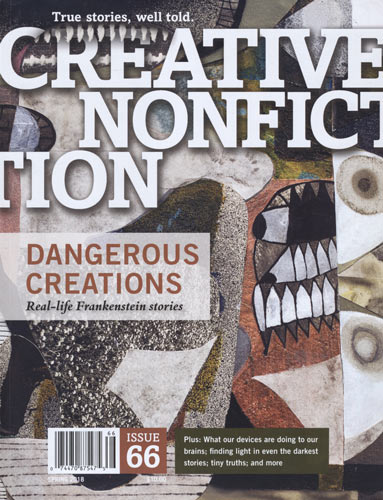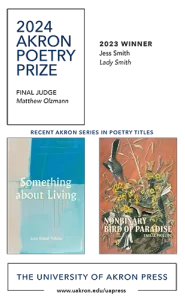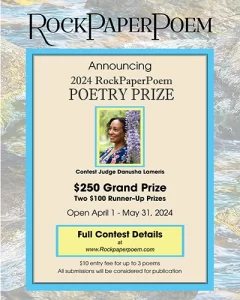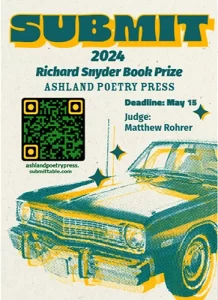Creative Nonfiction – Spring 2018
With Mary Shelley’s fiction as the creative muse, it’s unsurprising that Creative Nonfiction’s issue, dedicated to real life Frankenstein stories, boasts all six essays by women. But while editor Lee Gutkind warns, “this issue is not for the faint of heart,” I disagree: the horror elements sprung from Shelley’s novel remain peripheral. This issue establishes the need for compassion, no matter the monsters in our lives.
With Mary Shelley’s fiction as the creative muse, it’s unsurprising that Creative Nonfiction’s issue, dedicated to real life Frankenstein stories, boasts all six essays by women. But while editor Lee Gutkind warns, “this issue is not for the faint of heart,” I disagree: the horror elements sprung from Shelley’s novel remain peripheral. This issue establishes the need for compassion, no matter the monsters in our lives.
Kelly Hedglin Bowen seeks to be compassionate to herself and her son in her essay “Mystic Trinities,” excerpted from her memoir in-progress. When Bowen and her husband undergo fertility treatment, she becomes pregnant with triplets: a single child and a set of twins. However, her unborn babies wind up with twin-to-twin transfusion syndrome, where the twins’ circulatory systems could fuse. She has to make the choice on whether to abort the twins or risk all three children. Bowen blends the scientific with the personal, beginning her essay not with the diagnosis or her invitro, but with her Catholic upbringing. She grounds her already devastating emotional choice as a mother with an added layer of her Catholic childhood. She makes her choice and when her son asks innocently, ‘“Mom, imagine if there were three of me,”’ Bowen acts with compassion towards herself and her five-year-old: ‘“Then I would love all three of you,”’ she promises.
In “The Makeup of a Monster,” Jamie Zvirzdin tackles the makeup industry and beauty expectations for women. Though she frames the essay as a horror piece—mimicking the opening of the 1931 Frankenstein film: “I think it will thrill you. It may shock you. It might even enrage you”—the essay is not horrifying. She challenges the beauty status quo and questions whether women impose these standards of body image on themselves. Her greatest strength in this essay is that she never blames women who cave to the need to be beautiful and therefore worthy of love. Zvirzdin grew up in the Mormon church and much of her essay focuses on the performance of gender and beauty, especially around religious expectations. “The righteous were supposed to be strong and beautiful and cheerful and content [ . . . ] If you weren’t happy, it was probably your own damn fault.” Over the course of the essay, Zvirzdin recognizes her learned behaviors around beauty and then must unlearn them, finding compassion for herself as a person who does not need to hide her face, and for those who choose to pick up the concealer.
Pat Falk’s “Piecing it Together” won the runner up for best essay prize and marches firmly into the realm of true horror. Falk narrates the real-life murder of Barbara Lofrumento, whose parents took her to a doctor for an illegal abortion in 1962. But when Barbara dies in the doctor’s office, he cuts up her body with a power saw and hatchet then attempts to flee. If this isn’t horrific enough, Falk’s father is the doctor’s lawyer and the doctor is a family friend. Falk grew up in the midst of this mutilation story playing out in the media. She tells the murder in present tense, but once she interweaves her own story with Barbara’s, she balances an older reflective narrator with the fear she had as an eleven-year old child. She asks, “Could this happen to me?” while also noting, “Barbara’s story can be found only in silence, in shreds. Like Frankenstein’s monster, her ghost roams the arctic of our indifference.” And just as Falk acknowledges both her childhood self and her adult perspective, she also recognizes that due to the trauma of this experience, she can easily lash out against those she loves. Even now, as an adult, she must keep herself in check and choose compassion.
Due to the 1931 Frankenstein film, the popular conception of Frankenstein is the monster. But really, Dr. Frankenstein is the creator. Dedicating this issue to Frankenstein stories, Creative Nonfiction forces readers to reimagine our conceptions of horror and monstrosity, because the antidote to becoming inhuman and monstrous is to see the monsters in our lives as lessons toward empathy and kindness.
[www.creativenonfiction.org]





